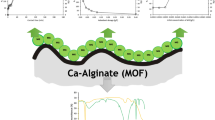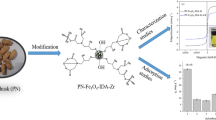Abstract
Background, aim, and scope
Dye pollutants are a major class of environmental contaminants. Over 100,000 dyes have been synthesized worldwide and more than 700,000 tons are produced annually and over 5% are discharged into aquatic environments. The adsorption or sorption is one of the most efficient methods to remove dye and heavy metal pollutants from wastewater. However, most of the present sorbents often bear some disadvantages, e.g. low sorption capacity, difficult separation of spoil, complex reproduction, or secondary pollution. Development of novel sorbents that can overcome these limitations is desirable.
Materials and methods
On the basis of the chemical coprecipitation of calcium oxalate (CaC2O4), bromopyrogallol red (BPR) was embedded during the growing of CaC2O4 particles. The ternary C2O4 2––BPR–Ca2+ sorbent was yielded by the centrifugation. Its composition was determined by spectrophotometry and AAS, and its structure and morphology were characterized by powder X-ray diffraction (XRD), laser particle-size analysis, and scanning electron microscopy (SEM). The adsorption of ethyl violet (EV) and heavy metals, e.g. Cu(II), Cd(II), Ni(II), Zn(II), and Pb(II) were carried out and their removal rate determined by spectrophotometry and ICP-OES. The adsorption performance of the sorbent was compared with powder activated carbon. The Langmuir isothermal model was applied to fit the embedment of BPR and adsorption of EV.
Results
The saturation number of BPR binding to CaC2O4 reached 0.0105 mol/mol and the adsorption constant of the complex was 4.70 × 105 M–1. Over 80% of the sorbent particles are between 0.7 and 1.02 μm, formed by the aggregation of the global CaC2O4/BPR inclusion grains of 30–50 nm size. Such a material was found to adsorb cationic dyes selectively and sensitively. Ethyl violet (EV) was used to investigate the adsorption mechanism of the material. One BPR molecule may just bind with one EV molecule. The CaC2O4/BPR inclusion material adsorbed EV over two times more efficiently than the activated carbon. The adsorption of EV on the CaC2O4/BPR inclusion sorbent was complete in only 5 min and the sedimentation complete in 1 h. However, those of EV onto activated carbon took more than 1.5 and 5 h, respectively. The treatment of methylene blue and malachite green dye wastewaters indicated that only 0.4% of the sorbent adsorbed over 80% of color substances. Besides, the material can also adsorb heavy metals by complexation with BPR. Over 90% of Pb2+, and approximately 50% of Cd2+ and Cu2+, were removed in a high Zn2+-electroplating wastewater when 3% of the material was added. Eighty-six percent of Cu2+, and 60% of Ni2+ and Cd2+, were removed in a high Cd2+-electroplating wastewater.
Discussion
The embedment of BPR into CaC2O4 particles responded to the Langmuir isothermal adsorption. As the affinity ligand of Ca2+, BPR with sulfonic groups may be adsorbed into the temporary electric double layer during the growing of CaC2O4 particles. Immediately, C2O4 2– captured the Ca2+ to form the CaC2O4 outer enclosed sphere. Thus, BPR may be released and embedded as a sandwich between CaC2O4 layers. The adsorption of EV on the sorbent obeyed the Langmuir isothermal equation and adsorption is mainly due to the ion-pair attraction between EV and BPR. Different from the inclusion sorbent, the activated carbon depended on the specific surface area to adsorb organic substances. Therefore, the adsorption capacity, equilibrium, and sedimentation time of the sorbent are much better than activated carbon. The interaction of heavy metals with the inclusion sorbent responded to their coordination.
Conclusions
By characterizing the C2O4 2––BPR–Ca2+ inclusion material using various modern instruments, the ternary in situ embedment particle, [(CaC2O4)95(BPR)] n 2n–, an electronegative, micron-sized adsorbent was synthesized. It is selective, rapid, and highly effective for adsorbing cationic dyes and heavy metals. Moreover, the adsorption is hardly subject to the impact of electrolytes.
Recommendations and perspectives
The present work provides a simple and valuable method for preparing the highly effective adsorbent. If a concentrated BPR wastewater was reused as the inclusion reactant, the sorbent will be low cost. By selecting the inclusion ligand with a special structure, we may prepare some particular functional materials to recover the valuable substances from seriously polluted wastewaters. The recommended method will play a significant role in development of advanced adsorption materials.




Similar content being viewed by others
References
Antoniadis V, Tsadilas CD, Ashworth DJ (2007) Monometal and competitive adsorption of heavy metals by sewage sludge-amended soil. Chemosphere 68:489–494
Chatterjee D, Dasgupta S (2005) Visible light induced photocatalytic degradation of organic pollutants. J Photochem Photobiol C Photochem Rev 6:186–205
Chen JS, Liu MC, Zhang JD, Xian YZ, Jin LT (2003) Electrochemical degradation of bromopyrogallol red in presence of cobalt ions. Chemosphere 53:1131–1136
Chen JY, Zhu DQ, Sun C (2007) Effect of heavy metals on the sorption of hydrophobic organic compounds to wood charcoal. Environ Sci Technol 41:2536–2541
Donlagic J, Levec J (1998) Comparison of catalyzed and noncatalyzed oxidation of azo dye and effect on biodegradability. Environ Sci Technol 32:1294–1302
Gao HW (1992) Determination of Ca2+ in natural water by dual-wavelength spectrophotometry. Shanghai Environ Sci 11(8):28–29
Gong RM, Li M, Yang C, Sun YZ, Chen J (2005) Removal of cationic dyes from aqueous solution by adsorption on peanut hull. J Hazard Mater B 121:247–250
González M, Mingorance MD, Sánchez L, Peña A (2008) Pesticide adsorption on a calcareous soil modified with sewage sludge and quaternary alkyl-ammonium cationic surfactants. Environ Sci Pollut Res 15:8–14
Hassouna MEM, Elsuccary SAA (2002) Determination of oxalate based on its enhancing effect on the oxidation of Mn(II) by periodate. Talanta 56:193–202
Janos P (2003) Sorption of basic dyes onto iron humate. Environ Sci Technol 37:5792–5798
Jiang SY, Hong Y, Zhou RF, Gao TY (2006) Pretreatment of dye wastewater by electrolysis process. J Tongji Univ Nat Sci 34:638–641
Kadirvelu K, Karthika C, Vennilamani N, Pattabhi S (2005) Activated carbon from industrial solid waste as an adsorbent for the removal of Rhodamine-B from aqueous solution kinetic and equilibrium studies. Chemosphere 60:1009–1017
Laasri L, Khalid Elamrani M, Cherkaoui O (2007) Removal of two cationic dyes from a textile effluent by filtration-adsorption on wood sawdust. Environ Sci Pollut Res 14:237–240
Li Y, Xi DL (2004) Decolorization and biodegradation of dye wastewaters by a facultative-aerobic process. Environ Sci Pollut Res 11:372–377
Liu W, Huang F, Liao Y, Zhang J, Ren G, Zhuang Z, Zhen J, Lin Z, Wang C (2008) Treatment of CrVI-containing Mg(OH)2 nanowaste. Angew Chem Int Ed 47:5619–5622
Mall ID, Srivastava VC, Agarwal NK, Mishra IM (2005) Adsorptive removal of malachite green dye from aqueous solution by bagasse fly ash and activated carbon-kinetic study and equilibrium isotherm analyses. Colloid Surf A 264:17–28
Maloney JP, Halbower AC, Fouty BF, Fagan KA, Balasubramaniam V, Pike AW, Fennessey PV, Moss M (2000) Systemic absorption of food dye in patients with sepsis. New Engl J Med 343:1047–1049
Mane VS, Mall ID, Srivastava VC (2007) Use of bagasse fly ash as an adsorbent for the removal of brilliant green dye from aqueous solution. Dyes Pigm 73:269–278
McMullan G, Meehan C, Conneely A, Kirby N, Robinson T, Nigam P, Banat IM, Marchant R, Smyth WF (2001) Microbial decolourisation and degradation of textile dyes. Appl Microbiol Biotechnol 56:81–87
Mohanty K, Naidu JT, Meikap BC, Biswas MN (2006) Removal of crystal violet from wastewater by activated carbons prepared from rice husk. Ind Eng Chem Res 45:5165–5171
Moosvi S, Kher X, Madamwar D (2007) Isolation characterization and decolorization of textile dyes by a mixed bacterial consortium JW-2. Dyes Pigm 74:723–729
Noroozi B, Sorial GA, Bahrami H, Arami M (2007) Equilibrium and kinetic adsorption study of a cationic dye by a natural adsorbent—silkworm pupa. J Hazard Mater B 139:167–174
Potapova I, Mruk R, Hübner C, Zentel R, Basché T, Mews A (2005) CdSe/ZnS nanocrystals with dye-functionalized polymer ligands containing many anchor groups. Angew Chem Int Ed 44:2437–2440
Rezić I, Steffan I (2007) ICP-OES determination of metals present in textile materials. Microchem J 85:46–51
Scancar J, Milacic R, Benedik M, Bukovec P (2000) Determination of trace elements and calcium in bone of the human iliac crest by atomic absorption spectrometry. Clin Chim Acta 293:187–197
Sciban M, Radetic B, Kevresan D, Klasnja M (2007) Adsorption of heavy metals from electroplating wastewater by wood sawdust. Bioresource Technol 98:402–409
Senthilkumaar S, Porkodi K (2005) Heterogeneous photocatalytic decomposition of crystal violet in UV-illuminated sol-gel derived nanocrystalline TiO2 suspensions. J Colloid Interf Sci 288:184–189
Sudipta C, Sandipan C, Bishnu PC, Akhil RD, Arun KG (2005) Adsorption of a model anionic dye, eosin Y, from aqueous solution by chitosan hydrobeads. J Colloid Interf Sci 288:30–35
Tuzen M, Citak D, Soylak M (2008) 5-Chloro-2-hydroxyaniline–copper(II) coprecipitation system for preconcentration and separation of lead(II) and chromium(III) at trace levels. J Hazard Mater 158:137–141
van der Zee FP, Bisschops IAE, Lettinga G, Field JA (2003) Activated carbon as an electron acceptor and redox mediator during the anaerobic biotransformation of azo dyes. Environ Sci Technol 37:402–408
Wang BS, Huang JL, Zhang J (2005) Oxidation of reactive dye wastewater with Fenton reagent. J Harbin Institute Technol 37:1280–1282
Wolfe TA, Demirel T, Baumann ER (1986) Adsorption of organic pollutants on montmorillonite treated with amines. Water Pollut Contr Ted 58:68–76
Yue QY, Li Q, Gao BY, Wang Y (2007) Kinetics of adsorption of disperse dyes by polyepicholorohydrin-dimethylamine cationic polymer/bentonite. Sep Purif Technol 54:279–290
Zhao SX, Castle GSP, Adamiak K (2005) Comparison of conduction and induction charging in liquid spraying. J Electrostat 63:871–876
Zhu LZ, Hu JZ, Shen XQ, Cha J (1995) Organobentonites as adsorbents for p-nitrophenol and its application in water treatment. Acta Sci Circumstantiae 15:316–321
Acknowledgement
We thank the National Key Technology R&D Program of China (Grant No. 2008BAJ08B13 and 2006BAJ08B10) and the State Key Laboratory Foundation of Science and Technology Ministry of China (No. PCRRK08003) for financially supporting this work.
Author information
Authors and Affiliations
Corresponding author
Additional information
Responsible editor: Allan Astrup Jensen
Electronic supplementary material
Below is the link to the electronic supplementary material.
Rights and permissions
About this article
Cite this article
Wang, HY., Gao, HW. Preparation of calcium oxalate—bromopyrogallol red inclusion sorbent and application to treatment of cationic dye and heavy metal wastewaters. Environ Sci Pollut Res 16, 339–347 (2009). https://doi.org/10.1007/s11356-008-0070-8
Received:
Accepted:
Published:
Issue Date:
DOI: https://doi.org/10.1007/s11356-008-0070-8




